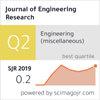An application of the preference selection index decision making method for parameters selection of FDM printing process
IF 2.2
4区 工程技术
Q3 ENGINEERING, MULTIDISCIPLINARY
引用次数: 0
Abstract
3D printing is an innovative technology used for producing functional prototypes and visualizing complex physical designs. Different 3D printing methods have been developed to cope with wide variety of mechanical components and materials. These techniques also speed up the mass manufacturing of complex components by quickly producing working prototypes. The performance of the 3D printing process can be assessed by the achieved outputs such as the mechanical qualities of the produced porotype, printing mass, and printing duration. Like any manufacturing process, how a process performs basically depends on the preference of the decision maker; whether all outputs are important or only a set of these outputs. Determining the desired performance is attained by the proper adjustment of process parameters. Selecting the optimal set of printing parameters, canE therefore, be thought of as multi-criteria decision-making (MCDM) problem since conflicting performance metrics are involved in the decision process. Substantial work has been made primarily on choosing printing machines and studying the effects of printing parameters, but with little focus on deciding parameters settings suitable for achieving the desired printing performance. For this purpose, a preference selection index (PSI)-MCDM model is proposed in this paper. The model is demonstrated using a ZORTRAX- M300 plus plastic 3D-printer as a case study. Multiple scenarios with different sets of decision criteria are presented to reflect users’ predilections. The outcomes show the model's capability to rank parameter combinations in a methodical manner.
偏好选择指数决策法在 FDM 印刷工艺参数选择中的应用
3D打印是一项创新技术,用于生产功能原型和可视化复杂的物理设计。不同的3D打印方法已经被开发出来,以应对各种各样的机械部件和材料。这些技术还通过快速生产工作原型加速了复杂部件的大规模生产。3D打印过程的性能可以通过实现的输出来评估,例如所生产的原型的机械质量,打印质量和打印时间。像任何制造过程一样,一个过程如何执行基本上取决于决策者的偏好;是所有输出都重要,还是只有其中一组输出重要。通过适当调整工艺参数来确定所需的性能。因此,选择最优的打印参数集被认为是一个多标准决策(MCDM)问题,因为决策过程中涉及到冲突的性能指标。大量的工作主要集中在选择印刷机和研究印刷参数的影响上,但很少关注如何确定适合实现所需印刷性能的参数设置。为此,本文提出了偏好选择指数(PSI)-MCDM模型。该模型演示使用ZORTRAX- M300加塑料3d打印机作为案例研究。提出了具有不同决策标准集的多个场景,以反映用户的偏好。结果表明,该模型能够有条不紊地对参数组合进行排序。
本文章由计算机程序翻译,如有差异,请以英文原文为准。
求助全文
约1分钟内获得全文
求助全文
来源期刊

Journal of Engineering Research
ENGINEERING, MULTIDISCIPLINARY-
CiteScore
1.60
自引率
10.00%
发文量
181
审稿时长
20 weeks
期刊介绍:
Journal of Engineering Research (JER) is a international, peer reviewed journal which publishes full length original research papers, reviews, case studies related to all areas of Engineering such as: Civil, Mechanical, Industrial, Electrical, Computer, Chemical, Petroleum, Aerospace, Architectural, Biomedical, Coastal, Environmental, Marine & Ocean, Metallurgical & Materials, software, Surveying, Systems and Manufacturing Engineering. In particular, JER focuses on innovative approaches and methods that contribute to solving the environmental and manufacturing problems, which exist primarily in the Arabian Gulf region and the Middle East countries. Kuwait University used to publish the Journal "Kuwait Journal of Science and Engineering" (ISSN: 1024-8684), which included Science and Engineering articles since 1974. In 2011 the decision was taken to split KJSE into two independent Journals - "Journal of Engineering Research "(JER) and "Kuwait Journal of Science" (KJS).
 求助内容:
求助内容: 应助结果提醒方式:
应助结果提醒方式:


